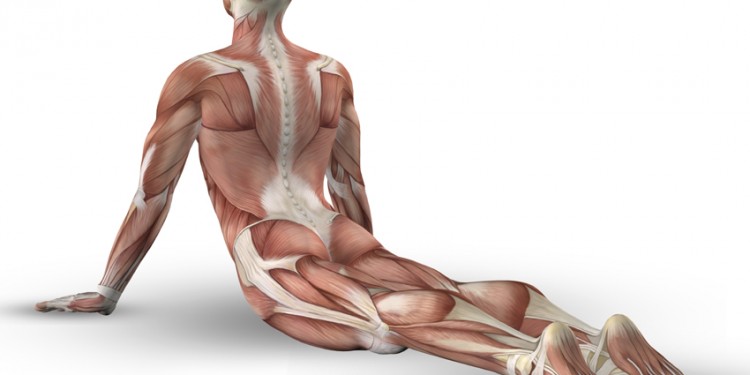Sitting up tall is a hard habit to learn. If you tend to round forward, a variety of postural issues can affect your musculoskeletal system, as seen with upper crossed syndrome. Whether you are sitting at a desk, driving your car, or texting on your phone, it's always ideal to focus on lifting your chest toward the sky to help align the vertebra. This stacking of your spine will help the other pieces of your kinetic chain fall into place. Yoga's many benefits include helping your body align while also bringing an awareness and mindfulness to your body as a whole integrative system. Try on these poses and notice how open and upright you feel after.
For 5 reasons on why you should teach yoga, follow the link to a great blog post by AFAA.
What is Upper Crossed Syndrome?
Upper crossed syndrome is characterized by rounded shoulders and a forward head posture. This pattern is common in individuals who sit a lot or who develop pattern overload from one-dimensional exercise. (1,2)
- Shortened muscles: Pectoralis major and minor, latissimus dorsi, teres major, upper trapezius, levator scapulae, sternocleidomastoid, scalenes
- Lengthened muscles: Lower and mid-trapezius, serratus anterior, rhomboids, teres minor, infraspinatus, posterior deltoid, and deep cervical flexors
- Common injuries associated with upper crossed syndrome: Biceps tendonitis, headaches, rotator cuff impingement, shoulder instability, and thoracic outlet syndrome
Why Heart Openers?
Most of us are rounded forward in our chest to some degree. Heart opening poses have several benefits for all of us-especially for those with this type of musculoskeletal misalignment. In heart opening poses, you work toward opening tight muscles on the anterior portion of the body while activating the often times lengthened or weak muscles on the posterior portion of the trunk.
In the poses below, the muscle groups involved in upper crossed syndrome are targeted. Included will be a deeper progression of the initial pose.
Yoga Poses
Anuvittasana or Standing Backbend
Basic Shape: Start Standing. Cactus your elbows out to the side.
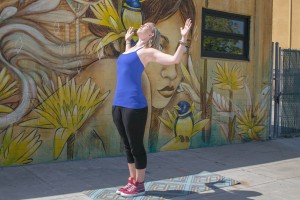
Go Deeper: Press feet into the ground. Roll your inner thighs back and hug them toward one another. Lengthen your tailbone down to create space in your spine. Draw your scapula down and in towards your spine. Broaden your collarbones and reach your heart towards the sky. Draw your front ribs back.
Dhanurasana or Floor Bow Pose
Basic Shape: Lay prone. Bend your knees and grab the inside of your feet (or grab the outside of your feet if this is not available).
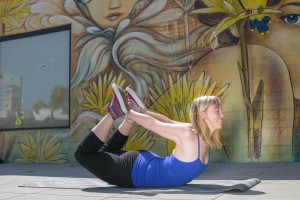
Go Deeper: Hug your inner thighs toward one another and lengthen your tailbone toward the back of your knees. Soften your glutes. Draw your navel in and up. Retract your shoulder blades and broaden through your chest. Lift your toes and the crown of your head toward the sky.
Ustrasana or Camel Pose
Basic Shape: Start standing on your knees, hip width distance apart. Toes can be tucked or untucked. Place your hands on either side of your sacroiliac (SI) joint. Stack your hips over your knees. Lift your heart upward and bend back.
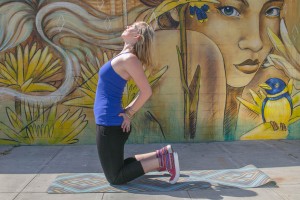
Go Deeper: Firm your inner thighs and internally rotate them slightly. Lengthen your tailbone down. Soften your glutes. Lift your low belly up and in. Retract your shoulder blades. Stay long in the back of your neck. Imagine a string attached to your sternum lifting you up. Reach for your heals if you can maintain the integrity of engagement throughout your body and the lift of your chest. Resist bending solely in your lumbar spine.
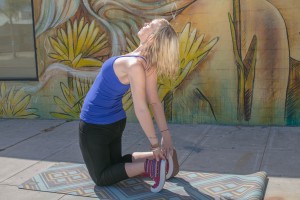
Bhujangasana or Cobra Pose
Basic Shape: Start by laying prone, toes untucked. Place your hands by your chest, pressing lightly on the ground as you lift your chest forward and up. Keep the back of your neck lengthened.
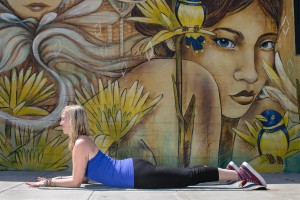
Go Deeper: Press your toe nails into the ground so hard that your knees and shins lift. Focus on pressing into your pinky toe nails to disengage your glutes slightly. Lengthen your tailbone back and pull your navel in. Traction your palms lightly back and reach your heart forward and up while you slide your scapula on the back of your ribs. Lengthen the crown of your head toward the sky.
Sukhasana Variation or Seated Lateral Stretch
Basic Shape: Start seated with your legs crossed. Release your right hand to the ground and lift your left hand up and over to the right.
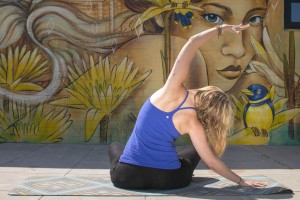
Go Deeper: Ground hips into the earth. Lift your chest upwards. Remain long in both sides of your torso as if lifting up and over a beach ball. Continue to lift the top of your head so you feel lightness and even a mild stretch in your neck. Reach actively through your fingertips.
Neck Stretches
Part 1: Basic Shape: Start seated tall. Gaze forward. Release your right ear toward your right shoulder.
Part 1: Go Deeper: Ground your hips into the earth. Sit tall. Retract and depress your left scapula. Relax your left arm and hand. Breathe. To add more stretch place your right hand on the top of your head and lightly guide movement in the direction of the stretch.
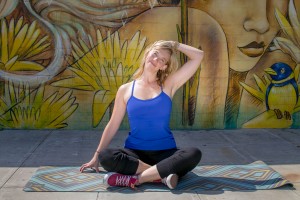
Part 2: Basic Shape: Start seated tall. Turn your chin toward your right shoulder and tilt it down.
Part 2: Go Deeper: Root you hips down. Lift your chest. Retract and depress your left scapula. Relax your left arm and hand. Breathe. To add more stretch, place your right hand on the top of your head and lightly guide movement in the direction of the stretch.
References:
- Clark MA, Sutton BG. Lucett SC. NASM Essentials of Personal Fitness Training, 4th ed. rev. Burlington, MA: Jones and Bartlett Learning; 2014.
- Clark MA, Lucett SC, Sutton BG. (2014). NASM Essentials of Corrective Exercise Training 1st ed. rev. Burlington, MA: Jones and Bartlett Learning.
The information provided is without warranty or guarantee and NASM disclaims any liability for decisions you make based on the information. Caution to Readers: The opinions, information and recommendations contained within articles, features, columns and advertisements of this blog are not necessarily those of the publisher, AFAA, NASM or their parent corporations or affiliates. The publisher and contributors cannot guarantee such materials are safe and proper for every reader or every reader's students and clients. Readers are urged to consult a physician before using or relying upon such materials, and to advise their students and clients to do so as well. This blog and its contents are sold without warranties or guarantees of any kind, expressed or implied, and the publisher and contributors disclaim any liability, loss or damage caused by the contents.

